Rail transport in Australia
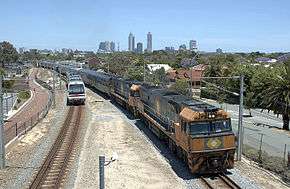
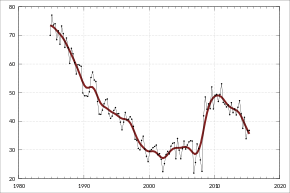
Rail transport in Australia is a crucial aspect of the Australian transport network. Rail in Australia is to a large extent state-based. The Australian rail network consists of a total of 41,461 kilometres (25,763 mi) of track on three major track gauges, of which 2,940 kilometres (1,830 mi) is electrified.
Except for a small number of private railways, most of the Australian railway network infrastructure is government-owned, either at the federal or state level. Most railway operators were once state government agencies, but with privatisation in the 1990s, private companies now operate the majority of trains in Australia.
The Australian federal government is involved in the formation of national policies, and provides funding for national projects. Rail transport in Australia has often been neglected in favour of the Australian road transport network.
National issues
Uniform gauge
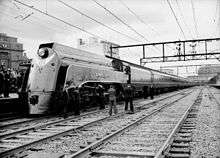
Very little thought was given in the early years of the development of the colony-based rail networks of Australia-wide interests. The most obvious issue to arise was determining a track gauge. Despite advice from London to adopt a uniform gauge, should the lines of the various colonies ever meet, gauges were adopted in different colonies, and indeed within colonies, without reference to those of other colonies. This has caused problems ever since.
Attempts to fix the gauge problem are by no means complete even in 2011. For example, the Wolseley to Mount Gambier line is isolated by gauge and of no operational value.
Electrification
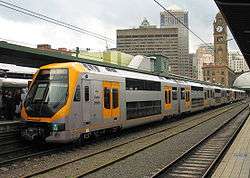
With the electrification of suburban networks, which began in 1919, a consistent electric rail traction standard was not adopted. Electrification began in Melbourne in 1919 using 1500 V DC. Sydney's lines were electrified from 1926 using 1500 V DC, Brisbane's from 1979 using 25 kV AC, and Perth's from 1992 using 25 kV AC. There has also been extensive non-urban electrification in Queensland using 25 kV AC, mainly during the 1980s for the coal routes. In 2008 plans were revealed to electrify Adelaide at 25 kV AC. 25 kV AC voltage has now become the international standard.[1]
History
The first railways in Australia were built by private companies, based in the then colonies of New South Wales, Victoria and South Australia.
The first railway was privately owned and operated and commissioned by the Australian Agricultural Company in Newcastle in 1831, a cast-iron fishbelly rail on an inclined plane as a gravitational railway servicing A Pit coal mine. The first steam-powered line opened in Victoria in 1854. The 4 km long Flinders Street to Sandridge (now Port Melbourne) line was opened by the Hobsons Bay Railway Company at the height of the Victorian gold rush.
In these early years there was very little thought of Australia-wide interests in developing the colony-based networks. The most obvious issue to arise was determining a uniform gauge for the continent. Despite advice from London to adopt a uniform gauge, should the lines of the various colonies ever meet, gauges were adopted in different colonies, and indeed within colonies, without reference to those of other colonies. This example has caused problems ever since at the national level.
In the 1890s, the establishment of an Australian Federation from the six colonies was debated. One of the points of discussion was the extent that railways would be a federal responsibility. A vote to make it so was lost narrowly, instead the new constitution allows "the acquisition, with the consent of a State, of any railways of the State on terms arranged between the Commonwealth and the State" (Section 51 xxxiii) and "railway construction and extension in any State with the consent of that State" (Section 51 xxxiv). However, the Australian Government is free to provide funding to the states for rail upgrading projects under Section 96 ("the Parliament may grant financial assistance to any State on such terms and conditions as the Parliament thinks fit").
Suburban electrification began in Melbourne in 1919 (1500 V DC). Sydney's lines were electrified from 1926 (1500 V DC), Brisbane's from 1979 (25 kV AC), and Perth's from 1992 (25 kV AC). Mainline electrification was first carried out in Victoria in 1954, closely followed by New South Wales which continued to expand their network. These networks have fallen into decline, in contrast to Queensland where 25 kV AC equipment was introduced from the 1980s for coal traffic.
Diesel locomotives were introduced to Australian railways from the early 1950s. Most units were of local design and construction, using imported British or American technology and power equipment. The three major firms were Clyde Engineering partnered with GM-EMD, Goninan with General Electric, and AE Goodwin (later Comeng) with the American Locomotive Company (ALCO). The major British company was English Electric, with Swiss firm Sulzer also supplying some equipment.[2] This continues today, with Downer Rail and UGL Rail the modern incarnations of Clyde and Goninan respectively.
Milestones
Note Narrow gauge below is 1,067 mm (3 ft 6 in), standard gauge below is 1,435 mm (4 ft 8 1⁄2 in) and broad gauge below is 1,600 mm (5 ft 3 in)
- 1831 – New South Wales – Australian Agricultural Company's cast-iron fishbelly rail on an inclined plane as a gravitational railway servicing A Pit coal mine.
- 1837 – New South Wales – Australian Agricultural Company's cast-iron fishbelly rail on an inclined plane as a gravitational railway servicing B Pit coal mine.
- 1842 – New South Wales – Australian Agricultural Company's cast-iron fishbelly rail on an inclined plane as a gravitational railway servicing C Pit coal mine.
- 1854 – South Australia – (horse-drawn line) Goolwa to Port Elliot
- 1854 – Victoria – First steam powered railway from Melbourne to Sandridge (Port Melbourne).
- 1855 – New South Wales – standard gauge steam powered railway from Sydney to Parramatta opened.
- 1856 – South Australia – broad gauge Adelaide to Port Adelaide railway opened
- 1865 – Queensland – narrow gauge Ipswich to Bigges Camp (renamed Grandchester in honour of occasion) on the way to Toowoomba railway opened, first narrow gauge main line in the world.[3]
- 1871 – Tasmania – Deloraine to Launceston railway opened as broad gauge, converted to narrow gauge in 1888
- 1879 – Western Australia – narrow gauge Geraldton to Northampton railway opened
- 1883 – Railways of New South Wales and Victoria meet at Albury
- 1887 – Railways of Victoria and South Australia meet at Serviceton
- 1888 – Railways of New South Wales and Queensland meet at Wallangara
- 1889 – Northern Territory – narrow gauge Darwin to Pine Creek railway opened
- 1891 – Western Australia – first sections of narrow gauge privately funded land grant Midland Railway opened, completed from Midland Junction to Walkaway in 1894.
- 1915 – Standard gauge Canberra to Queanbeyan railway opened
- 1917 – Standard gauge Trans-Australian Railway completed between Kalgoorlie and Port Augusta
- 1919 – Railways of New South Wales and South Australia meet at Broken Hill with break-of-gauge
- 1919 – First electric suburban trains run in Melbourne
- 1924 – Final section of North Coast line opens, linking Cairns to the rest of the Australan railway system
- 1925 – Great White Train is created to promote industry and tours in New South Wales.
- 1930 – Standard gauge Sydney–Brisbane railway completed with trains crossing the Clarence River on a train ferry until the opening of a bridge at Grafton in 1932.
- 1937 – Trans-Australian Railway extended to Port Pirie Junction and the broad gauge railway from Adelaide to Redhill extended to Port Pirie Ellen Street
- 1954 – first main line electrification, from Dandenong to Traralgon in Victoria
- 1962 – Albury to Melbourne standard gauge railway opened, completing the Sydney–Melbourne railway
- 1968 – Kalgoorlie to Perth standard gauge railway opened
- 1969 – Broken Hill to Port Pirie standard gauge railway opened, completing the Sydney–Perth railway
- 1980 – Tarcoola to Alice Springs standard gauge railway opened
- 1982 – Adelaide to Crystal Brook standard gauge railway opened
- 1989 – Electrification of the final section of the Brisbane-Rockhampton line, completing a ~2,100 km electrified network
- 1995 – Melbourne–Adelaide railway standard gauge railway completed
- 2004 – Adelaide–Darwin railway standard gauge railway completed
Government funding
While Australian federal governments have provided substantial funding for the upgrading of roads, since the 1920s they have not regularly funded investment in railways except for their own railway, the Commonwealth Railways, later the Australian National Railways Commission, which was privatised in 1997. They have considered the funding of railways owned by State Governments to be a State responsibility.
Nevertheless, Australian governments have made loans to the states for gauge standardisation projects from the 1920s to the 1970s. From the 1970s to 1996, the Australian Government has provided some grant funding to the States for rail projects, particularly the Keating Government's One Nation program, announced in 1992, which was notable for standardising the Adelaide to Melbourne line in 1995. Significant government funding was also made available for the Alice Springs to Darwin Railway, opened in 2004. Substantial funding is now being made available for freight railways through the Australian Rail Track Corporation and the AusLink land transport funding program.
Australian Rail Track Corporation
The Australian Rail Track Corporation (ARTC) is a federal government owned corporation established in 1997 that owns, leases, maintains and controls the majority of main line standard gauge railway lines on the mainland of Australia, known as the Designated Interstate Rail Network (DIRN).
In 2003 the Australian and New South Wales Governments agreed that ARTC would lease the NSW interstate and Hunter Valley networks for 60 years. As part of this agreement, ARTC agreed to an A$872 million investment programme on the interstate rail network.[4] The funding sources for the investment included an Australian Government equity injection into ARTC of $143 million and a funding contribution of almost $62 million by the New South Wales Government.
AusLink
Under the AusLink program introduced in July 2004, the Australian Government has introduced the opportunity for rail to gain access to funds on a similar basis to that of roads. AusLink established a defined national network (superseding the former National Highway system) of important road and rail infrastructure links and their intermodal connections.
Rail funding has been announced for signalling upgrades to numerous railway lines, gauge conversion of existing broad gauge lines in Victoria to standard gauge, new rail links to intermodal freight precincts, and extensions to existing crossing loops to permit longer trains to operate.
Funding is focused on the National Network, including the following rail corridors, connecting at one or both ends to State Capital Cities:
- Sydney–Melbourne railway
- Sydney–Brisbane railway
- Sydney to Adelaide, via Sydney–Melbourne railway to Cootamundra and then the Cootamundra–Parkes line, Parkes–Crystal Brook line and the Adelaide–Darwin railway
- Melbourne-Adelaide railway
- Adelaide to Perth – Sydney–Perth railway
- Adelaide–Darwin railway
- Brisbane to Townsville – the North Coast railway line in Qld.
- Townsville to Mount Isa
- Hobart to Burnie, including link to Bell Bay, Tasmania
- Melbourne to Mildura via Geelong
- Sydney to Dubbo
- Some urban links in Sydney, Melbourne, Brisbane, Perth and Adelaide, connecting the long distance links to each other and to ports and airports
- Hunter Region rail links from Dubbo to Newcastle via the Dubbo-Merrygoen, Merrygoen–Binnaway, Binnaway–Werris Creek and Werris Creek–Port of Newcastle lines and the Merrygoen–Gulgong, Merrygoen–Sandy Hollow and Sandy Hollow–Muswellbrook lines
Infrastructure Australia
After the 2007 federal election, the government body Infrastructure Australia was created to oversee all rail, road, airports and other infrastructure at a national level.
Rail infrastructure

Construction and maintenance of network infrastructure is consolidated into non-profit government bodies and contracted private: in the case of the interstate network and various non-urban railways of New South Wales, Victoria and Western Australia, the Australian Government-owned Australian Rail Track Corporation (ARTC); the New South Wales Regional Network, John Holland Rail; and rail infrastructure throughout the southern half of Western Australia, Brookfield Rail.
ARTC "has a working relationship with Queensland Rail about the use of the 127 kilometres of standard gauge line between the Queensland border and Fisherman Island. ARTC intends to start discussions with Queensland about leasing this track once the NSW arrangements are bedded down".[5] ARTC also maintains the NSW Hunter Valley network under contract.
On 1 January 2012, John Holland commenced the operation and maintenance of the New South Wales Regional Network under contract from Transport for New South Wales, comprising 2,700 kilometres of operational freight and passenger rail lines.[6]
Brookfield Rail has a lease until 2049 on 5,100 kilometres of Western Australian rail infrastructure, from Geraldton in the north, to Leonora and Kalgoorlie in the east, and south to Esperance, Albany and Bunbury.[7][8] It is responsible for maintaining the network and granting access to operators.
Other railways continue to be integrated, although access to their infrastructure is generally required under National Competition Policy principles agreed by the Federal, State and Territory governments:
- Queensland – Queensland Rail and Aurizon
- Tasmania – TasRail
- Victorian non-interstate lines – V/Line and Metro Trains Melbourne
- South Australian non-interstate lines – Genesee & Wyoming
- Tarcoola-Darwin line – Genesee & Wyoming
Operators
Rail freight


The major freight operators on the rail networks (excluding integrated mining railways) are:
- Aurizon
- Pacific National – part of Asciano
Other rail freight operators include:
- Genesee & Wyoming Australia
- Qube Logistics (Rail)
- SCT Logistics
- Southern Shorthaul Railroad
- TransVolution Rail
Licensing of personnel with nationally recognised credentials facilitates the transfer of those employees from one state or operator to another, as traffic demands.
Total freight movement
Including the mining railways, in 2011–12, there were 290.6 billion tonne kilometres of freight moved by rail.[9] Overall railway freight in Australia is dominated by bulk freight, primarily iron ore and coal. In 2012–13 Australian railways carried over 1 billion tonnes of freight, 97 per cent of which were bulk movements. Intrastate bulk freight in Western Australia—principally iron-ore movements—accounted for 56 per cent of national rail freight tonnes. Bulk movements in Queensland and NSW—principally coal—were 22 per cent and 17 per cent, respectively.[10]
Long-distance passenger
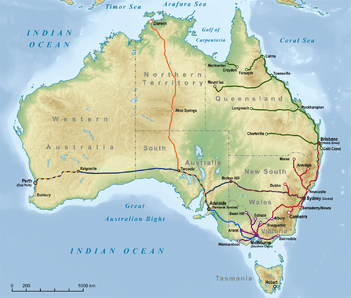
State Government owned rail services: Great Southern Rail lines:
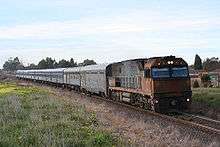
Long-distance passenger rail operates on a state-by-state basis. The main companies that provide service are GSR, NSW TrainLink, QR and VLine.
The Great Southern Rail operates three passenger trains:
- The Indian Pacific (Sydney–Adelaide–Perth): 1 round trip per week
- The Ghan (Adelaide–Alice Springs–Darwin): 1 round trip per week
- The Overland (Melbourne–Adelaide): 2 round trips per week
New South Wales government-controlled NSW TrainLink operates ten long-distance routes. All routes originate from Sydney:
- Grafton XPT: daily
- Casino XPT: daily
- Brisbane XPT: daily
- Canberra Xplorer: 2 round trips per day
- Melbourne XPT: 2 round trips per day
- Griffith Xplorer: 1 round trip per week
- Central West XPT: daily
- Outback Xplorer: 1 round trip per week
- Armidale Xplorer: daily
- Moree Xplorer: daily
V/Line, a nonprofit organization marginally under the control of the Victoria government, operates both regional and long distance services along the Victorian regional network. Eight services in the long distance category, all of which operate from Melbourne, are available:
- Warrnambool line: 3 round trips per day (proposal to make it 5)2 trips on Sunday.
- Ararat line: 3 round trips per weekday, 2 round trips per Sat/Sun
- Swan Hill line: 2 round trips per day
- Echuca line: 1 round trip per weekday, 2 round trips per Sat/Sun
- Shepparton line: 4 round trips per weekday, 3 round trips per Sat/Sun
- Albury line: 3 round trips per day
- Bairnsdale line: 3 round trips per Mon-Sat, 2 round trips per Sun
Queensland Rail, a state entity, operates several passenger lines under its Traveltrain subsidiary. Six routes target the domestic market:
- Spirit of Queensland (Brisbane–Cairns express): 2 round trips per week at present, with a third unit due for introduction in 2014.
- The Sunlander (Brisbane–Cairns): Retired from service as of 2014
- Electric Tilt Train (Brisbane–Rockhampton express): 12 round trips per week
- Spirit of the Outback (Brisbane–Longreach): 2 round trips per week
- The Westlander (Brisbane–Charleville): 2 round trips per week
- The Inlander (Townsville–Mount Isa): 2 round trips per week
An additional three Queensland Rail routes are aimed at providing tourist services. These services are operated under contract:
- The Savannahlander (Cairns–Forsayth): 1 round trip per week
- The Gulflander (Normanton–Croydon): 1 round trip per week
- Kuranda Scenic Railway (Cairns–Kuranda): daily
The Public Transport Authority, a government agency of Western Australia, operates various buses and four long distance rail routes through its Transwa subsidiary. All routes originate from Perth:
- The Prospector: 9 round trips per week
- AvonLink: 1 round trip per day
- MerredinLink: 3 round trips per week
- The Australind: 2 round trips per day
Medium-speed passenger services


Australian passenger services are generally quite slow (for example, the approximately 960 km journey from Sydney to Melbourne takes about 11.5 hours, an average of about 83 km/h).[11] However, several medium-speed rail services operate on existing track that has been upgraded to accommodate faster services and/or tilting technology.
- In Western Australia Westrail began using high-speed diesel railcars in 1971 on the Prospector service from Perth to Kalgoolie, and set a new Australian speed record. Now operated by Transwa, the railcars were replaced in 2004 with new units capable of 200 km/h (124 mph), although track condition currently limits this to 160 km/h (99 mph).[12] The same type of cars are used on the AvonLink service.[13]
- New South Wales commenced operations with XPT in 1982. Based on the British InterCity 125 train, it has a service speed of 160 km/h (99 mph) and set an Australian speed record of 193 km/h (120 mph) on a test run in 1992.[14] The train is not often used to its full potential, operating along winding steam-era alignments,[15] and at times has had the top speed limited due to track condition and level crossing incidents.
- New South Wales trialled the Swedish X 2000 tilt train in 1995. Propelled by two specially modified XPT power cars, the train carried passengers between Sydney and Canberra in an eight-week trial.[16]
- Queensland Rail's Tilt Trains operate Brisbane to Rockhampton with an electric train, Brisbane to Cairns with diesel. These routes were partially upgraded in the 1990s at a cost of A$590 million, with the construction of 160 km (99 mi) of deviations to straighten curves.[17] Both with a service speed of 160 km/h (99 mph),[18] the electric train set an Australian rail speed record of 210 km/h (130 mph) in 1999.[19]
- In Victoria the State Government upgraded railway lines as part of the Regional Fast Rail project, with V/Line operating VLocity diesel railcars at a maximum speed of 160 km/h (99 mph) over the lines.[20] In the early stages of the project the Victorian Government incorrectly referred to it as the 'Fast Train' or 'Very Fast Train', and this practice continues among some politicians and members of the public.[21][22][23]
High Speed Rail
High speed rail has been repeatedly raised as an option since the 1980s, and has had bipartisan support for research and land purchase.
The focus usually falls on Sydney to Melbourne where it is seen as a competitor to the busy Sydney-Melbourne air corridor, with Sydney to Brisbane also proposed. The benefits of regional city development are frequently raised.
A detailed study was undertaken from 2011-2013, after which the government indicated it would start purchasing land for a rail corridor. In 2016 the Prime Minister indicated a high speed rail link might be funded privately and by value capture.
Commuter passenger
- Sydney Trains, a New South Wales state entity, operates the Sydney suburban railway network.
- Metro Trains Melbourne, a private entity whose majority owner is MTR Corporation, operates the Melbourne suburban railway network. 16 lines serves various suburbs and outer neighbourhoods.
- V/Line, a non-profit organisation marginally under the control of the Victoria government, operates the Victorian regional network. In addition to long distance services, commuter bus and rail is available to connect Melbourne with exurban and regional cities along five lines.
- Queensland Rail through their City network division (formerly Citytrain), operates the South East Queensland railway network.
- Transperth trains operats the Perth's suburban rail network and is a division of Transperth. Both bus service and the 5 line Perth suburban railway network are run by this entity.
- Adelaide Metro, a South Australia government agency, operates the Adelaide suburban railway network. This system features six lines.
- The Skitube Alpine Railway is a private railway in the New South Wales snowfields. Owned by the Perisher Ski Resort, it connects the main entrance of this tourist destination with ski areas that are inaccessible via road. The line mainly operates underground.
Urban light rail and trams
- Yarra Trams, owned by the Victoria state government, operates the 29 line Melbourne tram network.
- The multinational transportation group Transdev operates the Inner West Light Rail line on behalf of Transport for New South Wales, which purchased the formerly privately owned light rail network in 2012.
- G:link operates a 13km light rail service on the Gold Coast. The line is part of the TransLink (SEQ) network.
- Adelaide Metro operates the Glenelg Tram, a small light rail system. The tram is publicly owned by the South Australian government.
Private railways
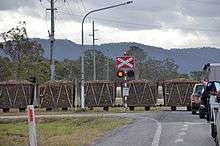

Cane
Tramways with 610 mm (2 ft) gauge for the transport of sugarcane have always been operated as private concerns associated with the relevant sugar cane mill. These tramways are quite advanced technically, with hand-me-down rails cascaded from the normal rails, remote-controlled brake vans, concrete sleepers in places, and tamping machines in miniature. The twenty or so separate tramways cooperate in research and development.
Timber
Tramways were often associated with the transport of timber to sawmills. Various gauges were used, including the 610 mm (2 ft) gauge which was also commonly used for cane haulage.
Wider gauges were sometimes used as well; Queensland had a number of 991 mm (3.25 ft) systems, some on wooden rails. In some areas 1,067 mm (3 ft 6 in) was used, a considerable investment of resources. In the early 21st century, the disused QR line to Esk 1,067 mm (3 ft 6 in) in the Brisbane Valley was used for timber haulage.
Iron ore
Four isolated heavy duty railways for the cartage of iron ore in the Pilbara region of Western Australia have always been private concerns operated as part of the production line between mine and port. These lines have pushed the limit of the wheel to rail interface which has led to much useful research of value to railways worldwide. In 2008, a fifth open access line built by Fortescue Metals Group opened. A sixth dual gauge open access iron ore network is proposed to the port of Oakajee.
References
- ↑ IEC 60850:2000 – "Railway Applications. Supply voltages of traction systems"
- ↑ "Diesel Traction (Chapter 7, page 473)". Technology in Australia 1788–1988. www.austehc.unimelb.edu.au. Retrieved 2009-09-06.
- ↑ Kerr, J. 'Triumph of Narrow Gauge' Boolarong Publications 1990
- ↑ "Media release, December 2003". John Anderson, Minister for Transport and Regional Services, www.ministers.dotars.gov.au. Archived from the original on 28 December 2005. Retrieved 2006-04-27.
- ↑ "Media release, December 2003". John Anderson, Minister for Transport and Regional Services, www.ministers.dotars.gov.au. Archived from the original on 28 December 2005. Retrieved 2006-04-27.
- ↑ "Country Rail Contracts". NSW Government. Retrieved 2 April 2015.
- ↑ Annual Report 31 December 2012 Brookfield Infrastructure Partners
- ↑ Non-urban rail routes covered by the WA rail access regime Economic Regulation Authority
- ↑ "Key Australian infrastructure statistics" (PDF). Commonwealth of Australia 2014.
- ↑ "BITRE Rail:Trainline 2" (PDF). Commonwealth of Australia, 2014.
- ↑ Sydney–Melbourne rail corridor
- ↑ http://www.transwa.wa.gov.au/Services/Prospector/tabid/39/language/en-US/Default.aspx Transwa website: Prospector – Perth to Kalgoorlie train service
- ↑ "Australia's fastest trains enter service". International Railway Journal. Simmons-Boardman Publishing Corporation. September 2003. Retrieved 2008-08-13.
- ↑ "Australian rail speed records". www.railpage.org.au. Retrieved 2008-08-13.
- ↑ Philip Laird (2001). Where Are We Now: National Patterns and Trends in Transport. Back on Track. UNSW Press. p. 31. ISBN 0-86840-411-X.
- ↑ David Bromage. "X2000 in Australia". www.railpage.org.au. Retrieved 2008-08-13.
- ↑ Philip Laird (2001). Appendix B: Australia's Gauge Muddle and Prospects. Back on Track. UNSW Press. p. 191. ISBN 0-86840-411-X.
- ↑ "Tilt Train Fleet Back to Normal Service". QR Corporate: Media Releases. www.corporate.qr.com.au. 24 May 2007. Retrieved 2008-08-13.
- ↑ "QR History: QR in the future". Queensland Rail Limited. Archived from the original on 19 July 2008. Retrieved 2008-08-13.
- ↑ "Public transport – VLocity trains". Department of Transport, State Government of Victoria. Retrieved 2008-08-13.
- ↑ Kenneth Davidson (22 September 2003). "Fast train is a big waste of money". The Age. Melbourne: www.theage.com.au. Retrieved 2008-08-13.
- ↑ David Broadbent (19 December 2004). "Not even Libs believe Doyle's buy-out promise". The Age. Melbourne: theage.com.au. Retrieved 2008-08-13.
- ↑ Editorial (14 March 2008). "Rail safety is vital, no matter how far down the track". Melbourne: theage.com.au. Retrieved 2008-08-13.
Carroll, Brian (1976), Australia's railway days : milestones in railway history, Macmillan, ISBN 978-0-333-21055-0
External links
 Across Australia by train travel guide from Wikivoyage
Across Australia by train travel guide from Wikivoyage